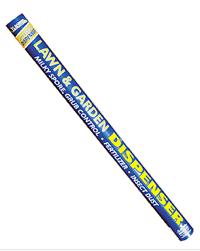Milky Spore - Grub and Mole Control
Ever look for a magic bullet product and thought that you could never find it? There is one product that will handle all of your lawn grub, Japanese Beetles, and mole problems with one single operation. That product is referred to as Milky Spore.
No More Singing From Song Birds:
When I purchased a 5 acre, beautifully wooded site, I never even gave it a thought that moles could be such a problem. But, after a few short years, the mole problem surfaced.
I was like most other homeowners and made a trip to the local garden superstore and purchased one of the most popular grub control applications. I won't mention the product name, but I can say the main active ingredient was Diazinon.
Did the mole problem go away? Absolutely, as advertised - for that year anyway. But I noticed that the yard had grown strangely quiet and I discovered dead birds around the property. Holy Cow, what was happening??
I didn't know it at the time, but the birds died because they ate the poisoned grubs as they surfaced. I felt terrible. One of the biggest lures of living in the woods was now gone.
I found a little known product called Milky Spore after considerable study. I thoroughly investigated this product as I didn't need to repeat my terrible mistake.
It truly sounded to good to be true - the application was entirely safe for birds, pets and humans. When it arrived I applied it as per the directions and the first application lasted a full 12 years. Wow!! I was convinced of the power of organic pest control after that.
How Does This Amazing Product Work?
The active ingredient of Milky Spore is a organically occurring bacteria which paralyzes their digestive system, resulting in lawn grub death. The grubs crawl to the lawn surface, die and spread the bacteria over the entire yard surface. After about 6 or 8 weeks your lawn is completely inoculated, and your grubs are completely gone, as are your Japanese Beetles.
What about the moles? They are not going to stick around. Their food source was taken away, and they won't come back until the grubs would return.
Being that this stuff is completely organic, after application there are no health concerns for your family, pets or the birds. Everyone is safe and no poisons to contaminate the lawn, the water table, or your song birds.
How You Apply Milky Spore:
I feel that the Milky Spore that is in the concentrated powder form works the best. I have found that it performs much better and longer than the granular form.
During the application of the concentrate, follow the instructions to the letter. Use the application spacing as a recommended maximum and do not skimp on material. It is also recommended that the appropriate applicator tube be used. It works very well and is very low-priced.
The application is as easy as filling the applicator with powder and jamming it into the ground at 36" spacing's. This will locate a grid-work of Milk Spore at 36 inch spacing over your entire lawn.
The last step is to water the powder into the lawn. The decrease in lawn grub activity will not be too much for about a month, then there will be full control in about 8 weeks.
Milky Spore - How Much Does It Cost?
Upon your initial impression, it will seem to be rather expensive. The cost works out to about 90 dollars per 10,000 square feet of lawn coverage. Consider the long term economics though. You will find that it is really a fantastic investment. Also, the cardboard applicator tube only costs about $8, and it will last for several applications as long as you take care of it.
Where Can Milky Spore be Purchased?
You can try to purchase it at larger garden stores. I just prefer to order online and receive front door delivery a few days later.
How Does This Product Rate?
I feel that this product not only delivers, it goes beyond the claims. With a cost of only 1/10 of a cent per square foot per year, you can't do much better than that. Therefore I give it the highest 10 star rating. So if you have these nasty pests, be sure to give Milky Spore a try. You will not be sorry you did.
comments powered by Disqus




































































